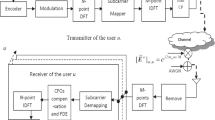Abstract
In this paper we present a method to build discrete channel (DC) models that speed up simulations and facilitates analysis of error control strategies. This method is based on nested hidden Markov models (HMM) and takes into account soft decision outputs. The verification of DC model made by simulations of wide-band DS-CDMA (WCDMA) traffics confirmed the validity of suggested approach. Realistic DC models based on nested HMM are built for different coding and interleaving schemes evaluation. At the same time these models provide a basis for different FEC-ARQ schemes studies.
Similar content being viewed by others
REFERENCES
W. Turin, Performance Analysis of Digital Transmission Systems, Computer Science Press, New York, 1990.
S. Srinivas and K. S. Shanmugan, An equivalent markov model for burst errors in digital channels, IEEE Trans. Com., Vol. COM-43, pp. 1347–1354, 1995.
H. S. Wang and N. Moayeri, Finite-state markov channel-A useful model for radio communication channels, IEEE Trans. Veh. Tech., Vol. VT-44, pp. 163–171, 1995.
F. Swarts and H. Ferreira, Markov characterization of channels with soft decision outputs, IEEE Trans. Com., Vol. COM-41, pp. 678–682, 1993.
J. R. Yee and E. J. Weldon, Evaluation of the performance of error-correcting codes on a Gilbert channel, IEEE Trans. Com., Vol. COM-43, pp. 2316–2323, 1995.
M. Zorzi and R. R. Rao, ARQ error control for fading mobile radio channels, IEEE Trans. Veh. Tech., Vol. VT-46, pp. 445–455, 1997.
H. S. Wang and P.-C. Chang, On verifying the first-order Markovian assumption for a Rayleigh fading channel model, IEEE Trans. Veh. Tech., Vol. 45, pp. 353–357, 1996.
J. Hagenauer and P. Hoeher, A Viterbi algorithm with soft-decision outputs and its applications, Proc. IEEE GLOBECOM'89, pp. 41.1.1–41.1.7, 1989.
A. Dempster et al., Maximum likelihood from incomplete data via the EM algorithm, Journal of the Royal Statistical Society, Vol. B 39, pp. 1–38, 1977.
L. E. Baum and T. Petrie, Statistical inference for probabilistic functions of finite state Markov chain, Annals of Mathematical Statistics, Vol. 37, pp. 1559–1563, 1966.
N. Nefedov, Generative Markov models for discrete channel modelling, Proc. IEEE PIMRC'97, Vol. 1, pp. 7–11, 1997.
A. Franchi and R. A. Harris, On the error burst properties of viterbi decoding, Proc. IEEE ICC'93, Vol. 2, pp. 1086–1091, 1993.
R. P. Aldridge and M. Ghanbari, Bursty error model for digital transmission channels, Electronics Letters, Vol. 31, pp. 2144–2145, 1995.
N. Nefedov, Discrete channel models for wireless data services, Proc. VTC'98, Vol. 1, pp. 683–687, 1998.
ETSI SMG2 905?97, Concept Group Alpha-Wideband Direct Sequence CDMA: Evaluation Document.
B. D. Fritchman, A binary channel characterization using partitioned Markov chains, IEEE Trans. Inform. Theory, Vol. IT-13, pp. 221–227, 1967.
N. Nefedov, Application of serially concatenated interleaved codes for wireless data transmission, Proc. Int. Symp. Wireless Communications, p. 7, 1998.
Author information
Authors and Affiliations
Rights and permissions
About this article
Cite this article
Nefedov, N. Discrete Channel Models Building for Wide-Band Error Control Strategies Evaluation. International Journal of Wireless Information Networks 7, 19–28 (2000). https://doi.org/10.1023/A:1009588000340
Issue Date:
DOI: https://doi.org/10.1023/A:1009588000340




